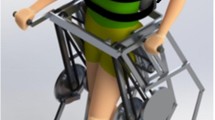Abstract
The present study aimed at designing a simple, yet safe transfer assistive device for lower-limb impaired individuals in the context of a developing country. A novel design methodology was adopted by combining the product design process with the concepts of biomechanics, anthropometry and human dynamics in a human–machine environment. The first phase of this paper elucidates design conceptualization using biomechanics in a human–machine environment. The second phase investigates experimental validation of the manufactured prototype concerning the user’s experience. Inertial parameters and design inputs were extracted from this setup that helped in the development of the 3D model. To evaluate the present device in terms of user’s comfort of use and level of physical strain, subjects including 19 healthy students serving as “patients” have participated in a laboratory-simulated setting. Data was collected based on user’s physiologic effort and rate of perceived exertion using heart rate monitoring device (Polar RS 400 heart taster) and Borg’s scale, respectively. The data was analyzed statistically and revealed that the regression equation for predicting the RPE from HR showed 31.3% of the variance in RPE was predictable from the level of HR. The ANOVA significance also indicates that the model is statistically significant with (p < 0.013). Similarly, the estimated strain level has computed in terms of %HRR, and the physical strain averaged over the subjects who performed the task (n = 19) was expressed in terms of (mean ± SD) %HRR were (16.21 ± 7.64%) which was a relatively smaller strain level as compared to the previous research report.
Access this chapter
Tax calculation will be finalised at checkout
Purchases are for personal use only
Similar content being viewed by others
References
Pechak, C., Thompson, M.: Global health education consortium. Disability and rehabilitation in developing countries. Global Health Education, Consortium (2007)
WHO: Assistive devices/ technologies: what WHO is doing: World Health Organization (2012). Available from: https://www.who.int/disabilities/technology/activities/en/#
Occupational Safety and Health Administration (OSHA): Safe patient handling preventing musculoskeletal disorders in nursing homes. U.S. Department of Labor. OSHA , Washington (2012)
Karavatas, S.G., Tavakol, K.: Concurrent validity of borg’s rating of perceived exertion in African-American Young adults, employing heart rate as the standard. IJAHSP 3(1), 1540–1580 (2005)
Janssen, T.W.J., Oers, V., Van Der Woude, L.U.C., Hollander, A.: Physical strain in daily life of wheelchair users with spinal cord injuries. Med. Sci. Sports Exerc. 26(6), 661–670 (1994)
Tajima, A.: Assessment of energy expenditure: an association between heart rate and oxygen uptake in daily physical activity. Int. J. Aanalyt. biosci. Jap. (2014)
Seid, K., Das, A.K.: Conceptual Design and Evaluation of a Novel Self-transfer-Assistive Device. Research into Design for a Connected World. Springer, Singapore pp. 919–928 (2019)
Reed, M.P.: Whole-body center of mass location in seated posture final report UMTRI-2006-39 (2006)
Chakrabati, D. (ed.): Indian anthropometric dimensions for ergonomic design practice. National Institute of Design, Ahmedabad 380 007, India (1997)
Chandler, R.F. et al.: Investigation of inertial properties of the human body. AMRL Technical Report. Wright-Patterson Air Force Base, pp. 74–137 (1975)
Clauser, C.E.: Weight, volume, and center of mass of segments of the human body. AMRL Technical Report. Wright-Patterson Air Force Base, pp. 69–70 (1969)
Dempster, W.T.: Space requirements of the seated operator. WADC Technical Report. Wright-Patterson Air Force Base, pp. 55–159 (1955)
Miller, D.I., Morrison, W.E.: Prediction of segmental parameters using the Hanavan human body model. Med. Sci. Sports Exerc. 7, 207–212 (1975)
Borg, G.: Ratings of perceived exertion and heart rates during short-term cycle exercise and their use in a new cycling strength test. Int. J. Sports Med. 3(3), 153–158 (1982)
Takahashi, Y., Manabe, G., Takahashi, K., Hatakeyama, T.: Basic study on self-transfer aid robotics. J. Robot. Mech. 18(1), 4–10 (2006)
Krishnan, R.H., Pugazhenthi, S.: Mobility assistive devices and self-transfer robotic systems for elderly, a review. Intel. Serv. Robot. 7(1), 37–49 (2014)
Rand-Scot: Easy Pivot Patient Lift Website (2014). https://www.randscot.com
Duy, V.H., Dao, T.T., Quang, N.T., Le, N.B.: Study on mechanical structure design for innovative multi-function assistive mobile robot. In: AETA 2015: Recent Advances in Electrical Engineering and Related Sciences. Springer, Cham, pp. 645–654 (2016)
Author information
Authors and Affiliations
Corresponding author
Editor information
Editors and Affiliations
Rights and permissions
Copyright information
© 2021 The Author(s), under exclusive license to Springer Nature Singapore Pte Ltd.
About this paper
Cite this paper
Mahammad, K.S., Das, A.K. (2021). Design, Development and Experimental Evaluation of a Transfer Assistive Device for Paraplegic Individuals Using Biomechanical Analysis. In: Chakrabarti, A., Poovaiah, R., Bokil, P., Kant, V. (eds) Design for Tomorrow—Volume 3. Smart Innovation, Systems and Technologies, vol 223. Springer, Singapore. https://doi.org/10.1007/978-981-16-0084-5_38
Download citation
DOI: https://doi.org/10.1007/978-981-16-0084-5_38
Published:
Publisher Name: Springer, Singapore
Print ISBN: 978-981-16-0083-8
Online ISBN: 978-981-16-0084-5
eBook Packages: EngineeringEngineering (R0)




